|
It is a festival like no other in India. Try to find a similar example around the world, and the first thing that comes to mind is Italy's Palio Di Siena, a horse race held twice a year. Little else resembles the scale of what happens in the Manipur valley during five-days of "Yaoshang" - the festival of Holi, in early March, for the state's majority Meitei people. Over the last few decades, sport has evolved into a key component of Yaoshang's customs and traditions. Communities across neighbourhoods, villages and towns - every locality tied to a sports or 'cultural' club - band together to host a series of sports events lasting up to four days. In a city like Imphal, the catchment area of the locality sports festival could feature anything between 50-100 households, or 2000. In a small village, the festival will include every resident. Its origins are hard to trace. There are 70-year-olds in Imphal who remember it from the time they were children. Smaller, newer groups began their festivals around the 1980s to keep the young away from the drug menace. Some say they had been started to prevent young men and women from focussing their energies on the Thabal Chongba (moonlight dancing), a ceremonial part of Yaoshang nights. In a conservative society, the dance was the only social license for young men and women to interact without parental permission, and horror of horrors, to even hold hands.
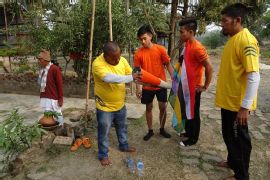 The festival begins, like at the Olympics, with the lighting of a torch. Neighbourhood representatives bring their torches to a 'sacred flame' inside the 400-year-old precincts of the Kangla Fort, the historical seat of the kings of Manipur. The torch is then taken through the streets of Imphal leading to the neighbourhood's festival venue, which could be an open field or a slice of land on a river embankment. In this picture, representatives of a youth group - from a neighbourhood called Khwai Lalambung Makhong, around 3km away -assemble the torch before the lighting ceremony to be held inside the citadel. They have a larger group waiting outside for them to emerge with their festival torch. The group is wearing Tshirts with the slogan, "Let's guide children for tomorrow."
 The ceremony is marked by solemnity and excitement, the Meitei women from the neighbourhood dressed in their traditional best. The Kangla priestess lights the torch and the group is ready to move outdoors and join the larger group, some localities sending as many as 150 for the torch-lighting and run ceremony.
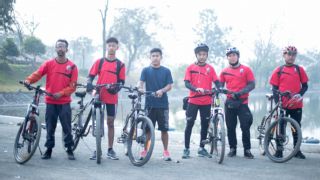 The festivals feature at least one competitive component from the traditional sports - football, athletics, volleyball, polo, indigenous wrestling, martial arts or the local version of rugby. Recently, more contemporary activities like cycling and skateboarding have also found its way into the Yaoshang sports programme. Here, the Manipur Cycle Riders at the Kangla Fort are on their way to be a part of the first Off-Town Yaoshang, which was doubling up as a celebration of Yaoshang and marking World Wildlife Day. The Off-Town Yaoshang, held 28kms south east of Imphal in the town of Yairipok Angtha, was a two-day festival featuring charity rides by cyclists and bikers, among other events. Road cycling has picked up in Manipur over the last five years, with the Manipur Cycle Club the oldest among its clubs and the Riders having started over two years ago.
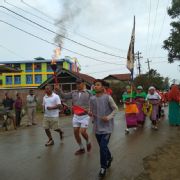 Athokpam Tomba Singh, retired fireman and swimmer, volleyball and basketball player for his department, brings home the torch to the Pa Ahkangba Cultural Club, in Mayaikoibi. The club was established in 1966 in a hut, now has a small building and represents a locality of about 500. Their sports festival will consist of short distance races, tug of war and jumps, along with activities involving women and children. The main torch-bearer is often the most prominent and (mandatory condition) reasonably fit athlete of the locality. He may be accompanied by a brass band if the organisers can afford it, but is always followed by women from the community, wearing traditional clothes and running shoes. No matter how long the route back home, the processions are well-organised, celebratory and energised.
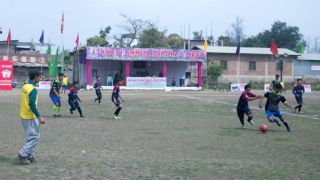 Football is the most popular sport across Manipur and a staple of every locality's sports festival across the valley. There is no exact date about when the five-day Yaoshang holiday began to be tied into the neighbourhood sports festivals. At this football match, the neighbourhood marks 2018 as its 36th year, other localities claim written records of their sports festivals over 70 years. It is the rare leikai (locality) that won't offer any football as part of its festival, the smallest of areas being turned into four-a-side pitches with mini-goalposts.
 A road in Soibam is turned into a four-lane athletic track and a junior 50m race is on, organised by the Citizens' Club of Soibam Leikei. Citizens' Club hosts arguably the biggest locality sports festivals in the state, with a catchment area of 10,000 people and features indoor and outdoor sports including football, cricket, volleyball, table tennis, football, sepak takraw. The Soibam Leikei is divided into four geographical "panas" (groups) - Marjing, Thangjing, Koubroo and Wangbren - who compete in different colours at the festival. Every pana fields a team in each sport, like the four kids in the race photo. The best player of every year's Yaoshang festival is nominated to carry Soibam Leikei's torch in the following year's celebrations. Funds are raised door to door and donations from the wealthier residents of the leikei
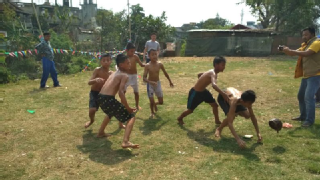 Yaoshang celebrations at the Keishamthong Longjam Leirak neighbourhood Development Club offered a rare glimpse of an indigenous sport called Yubi Lapki. Yubi means coconut, lapki means snatching and the sport is considered the Manipuri version of rugby. Some Meitei insist that rugby was born here and not in an English public school. After all, there's an oddly shaped "ball" that has to be put across a line. In the Keishamthong Longjam Leirak version it was not seven a side but each man for himself, every player and the coconut covered in oil.
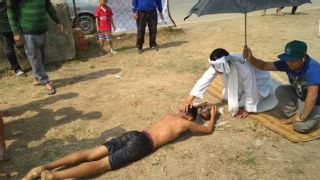 The field is a narrow strip of land on the roadside; the coconut is placed on the field, the players standing about six feet away. At a signal, they sprint to grab the coconut. The winner is whoever manages to grab and hold on to the yubi, evade the other five and land it at the foot of a ceremonial 'king' - dressed in white - seated at the end of a 75m run. There were consolation prizes of Rs 100 each and the winner pocketed Rs 500. The morning's festivities ended when the winner was found.
 During a March afternoon, an unexpected sight awaits on NH2 that runs north from Imphal towards Nagaland. On a primary school playground, next to the Thongjarok stream in Bishnupur, a women's cricket match is part of the valley's Yaoshang celebrations. The organisers had set up the venue with traditional bunting, the players were amateur but enthusiastic and the spectators interested and involved. In the country's north east, cricket itself is a rare sighting, and women's cricket even more so. Yet even as Yaoshang remains timeless in Manipur, in its sports festivals, maybe something is changing.
 Imphal's first-ever LGBTQ Sports Meet on the occasion of Yaoshang 2018 was held at the Tiddim Ground, halfway to the international airport, and lasted through the day. Athletics events featured as part of its programme and the first LGBTQ event ended with a cultural programme. The torch was carried from Kangla Fort to the Tiddim ground by Bishesh Huirem, Manipur's most famous transgender personality. The lighting of the flame and the conduct of the Sports Meet, organisers said, had served to integrate the transgender community right into the Yaoshang sports, which forms a central part of the culture of the mainstream Manipur valley.
|

